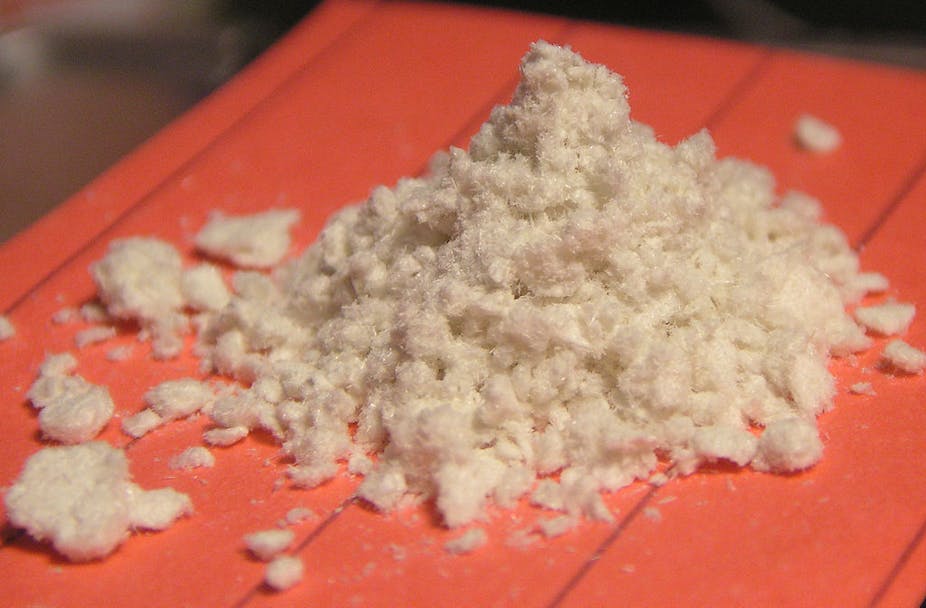The number of deaths caused by a group of mind altering drugs, including mephedrone, has increased over the past three years. And while toxicology reports also link the use of these substances to deaths from other causes, the speed at which new substances are created is making it difficult for authorities to keep up.
At the National Programme on Substance Abuse Deaths (NPSAD) at St George’s, University of London, we’ve been monitoring the rise of new psychoactive substances (NPS), including benzofurans, MDAI and methoxetamine, since 2005. According to our latest report the deaths from these substances rose six-fold from 10 in 2009 to 68 in 2012. The presence of the substances identified in post-mortem toxicology tests has also increased, from 12 cases in 2009 to 97 in 2012.
From information collected from forensic scientists, law enforcement, and other agencies, it’s clear that people are increasingly using these drugs. But even as misuse becomes more recognised, the authorities are one step behind in trying to stop it; just as new psychoactive substances become regulated, new molecules appear on the market and the cycle repeats.
Physical and psychological problems reported by health professionals from psychoactive substance use include dependence, psychoses, paranoia, as well as risky behaviour like injecting mephedrone, overdosing and poisonings that result in hospital admissions.
The worst case scenario is death by overdose (accidental or intentional), suicide (induced by psychiatric conditions including depression, anxiety, psychoses, caused or triggered by the drugs), and accidents resulting from impaired judgement, including traffic accidents, falls from heights and drowning.
Psychoactive substances
Although the composition of many new psychoactive substances is largely unknown, they may be derivatives of controlled or regulated psychoactive substances. We found many consumers use the internet to obtain or exchange psychoactive drug-related information. And despite the risks, advertising these drugs as “legal” and of “high purity” can make them more attractive because it suggests they are therefore safe.
But most of these chemicals have never been subject to proper scientific investigation or evaluation in laboratory or animal experiments, let alone human trials. This lack of knowledge and practical experience causes problems not only for potential consumers but also health and other professionals who may have to deal with consequent harmful effects.
Undertaking a risk assessment usually includes evaluating what acute or chronic effects it might have, along with medical or psychopathological features associated with use, such as increased blood pressure, cardiac problems and seizures.
Technical knowledge about recreational compounds appearing in the drug market in recent years is rarely obtained through reference books and scientific journals because basic research on them hasn’t taken place. Instead, information is often only gained after such substances have started causing harms to users. So despite increasing use, drug policy makers, EU regulators, drug enforcement agencies and individual health professionals have clear gaps in their knowledge.
We need more regular data and information to be collected from a range of sources to understand trends, how they are used, who is using them, and who is suffering adverse health consequences. Our report is the most comprehensive look at the world of new psychoactive substances involved in deaths. We collect information on individual fatalities from forensic toxicology laboratories and associated informal networks, pathologists, coroners and their staff, the Scottish Crime and Drug Enforcement Agency, Drug and Alcohol Action Teams – who all voluntarily supply information – and media reports. This requires regular communication and co-operation.
More clued up
But it’s clear that more information is needed to keep up with emerging and continuing drug trends, and if health professionals and the government are to be more clued up and ahead, rather than behind.
The way information is collected and when is also hugely important. Logging admissions to Accident & Emergency departments will pick up adverse outcomes quickly, but the full extent of their causes may not become evident until the conclusion of an inquest into any resulting deaths. These investigations may not be completed until six months, or longer, after the event. This means that some key information, which could inform treatment options and education, isn’t available until some time after the substances have appeared. So building a full picture will require effort and working across different boundaries.
Monitoring drug-related deaths will help us to contribute scientific data to the pool of knowledge to help inform potential users of the potential dangers, and help the health professionals who look after them if they become unwell. Deaths have gone up so we must find a way of reducing the number.

